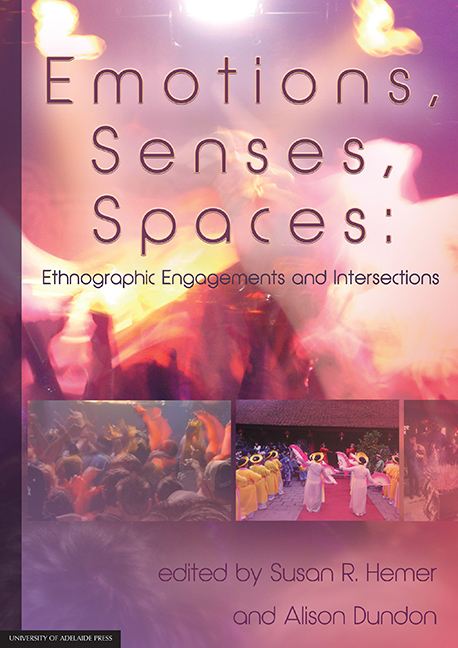Book contents
- Frontmatter
- Contents
- Biographies
- 1 Ethnographic intersections: Emotions, senses and spaces
- 2 ‘Dancing for joy’: Gender and relational spaces in Papua New Guinea
- 3 Creating the right ‘vibe’: Exploring the utilisation of space at Hip Hop concerts in Adelaide and Melbourne
- 4 Pontic dance: Feeling the absence of homeland
- 5 Emotional actors/Affective agents: Interspecies edgework and sociotechnical networks in the Spanish bullfight from horseback (rejoneo)
- 6 Sensual feasting: Transforming spaces and emotions in Lihir
- 7 Anxious spaces: The intersection of sexuality, the senses and emotion in fieldwork in Nepal
- 8 Interrupted research: Emotions, senses and social space in (and out of) the field
- 9 Voices in the park: The composition of sacred space and public place
- 10 Ngadha being-in-common: Emotional attachment to people and place in Flores, Indonesia
- 11 Trust your senses: Growing wine and making place in McLaren Vale
4 - Pontic dance: Feeling the absence of homeland
Published online by Cambridge University Press: 25 July 2017
- Frontmatter
- Contents
- Biographies
- 1 Ethnographic intersections: Emotions, senses and spaces
- 2 ‘Dancing for joy’: Gender and relational spaces in Papua New Guinea
- 3 Creating the right ‘vibe’: Exploring the utilisation of space at Hip Hop concerts in Adelaide and Melbourne
- 4 Pontic dance: Feeling the absence of homeland
- 5 Emotional actors/Affective agents: Interspecies edgework and sociotechnical networks in the Spanish bullfight from horseback (rejoneo)
- 6 Sensual feasting: Transforming spaces and emotions in Lihir
- 7 Anxious spaces: The intersection of sexuality, the senses and emotion in fieldwork in Nepal
- 8 Interrupted research: Emotions, senses and social space in (and out of) the field
- 9 Voices in the park: The composition of sacred space and public place
- 10 Ngadha being-in-common: Emotional attachment to people and place in Flores, Indonesia
- 11 Trust your senses: Growing wine and making place in McLaren Vale
Summary
Abstract
Pontic dance originated in the Pontos area of northern Turkey. It survived a genocide and exile of Pontians from that region in the 1920s as well as their migration to Australia thirty to forty years later. In this chapter, I discuss how Pontic dance, in both its choreographic and participatory modes, embodies the loss Pontians feel they have suffered as a result of these ruptures. Pontians assert that it is necessary to have a certain ‘feel’ in order to dance in an authentic way. Although this ‘feel’ may manifest itself in the bodily movements of the dance, it is an expression that comes from a sense of loss that Pontians inwardly feel and express through dance, particularly a loss of place and a waning of cultural practice. This loss is referenced in two ways: first, historically, the dances, their execution, costumes and musical instruments embody the loss of the former homeland. Second, the movements of the dance outwardly express the passion the dancers feel about what it means to be Pontian. This chapter explores how the performance space composed of the emotion and sensation of the dance makes present the absence of a way of life in Greece and the loss of the original homeland.
Introduction
Pontic Greeks have a characteristic way of dancing that developed over many centuries in the Pontos area of northern Turkey. The dance practices survived a genocide1 and their exile from that region in the 1920s as well as their migration to Australia thirty to forty years later. The movements of Pontic dance are different from that of Greek mainland or island dancing. Its dances range ‘from the most languid, slow, relaxed, effortless, shuffling steps to the most frenetic, tense, physically demanding and almost violent movement’ (Kilpatrick 1975:104), with the dancers’ feet covering a small space on the ground. In addition to foot movements, there is ‘flexing and rotation of the torso’ (105‑6), referred to as shimmying, which is characteristic of the style of Pontic dance.
- Type
- Chapter
- Information
- Emotions, Senses, SpacesEthnographic Engagements and Intersections, pp. 49 - 66Publisher: The University of Adelaide PressPrint publication year: 2016

